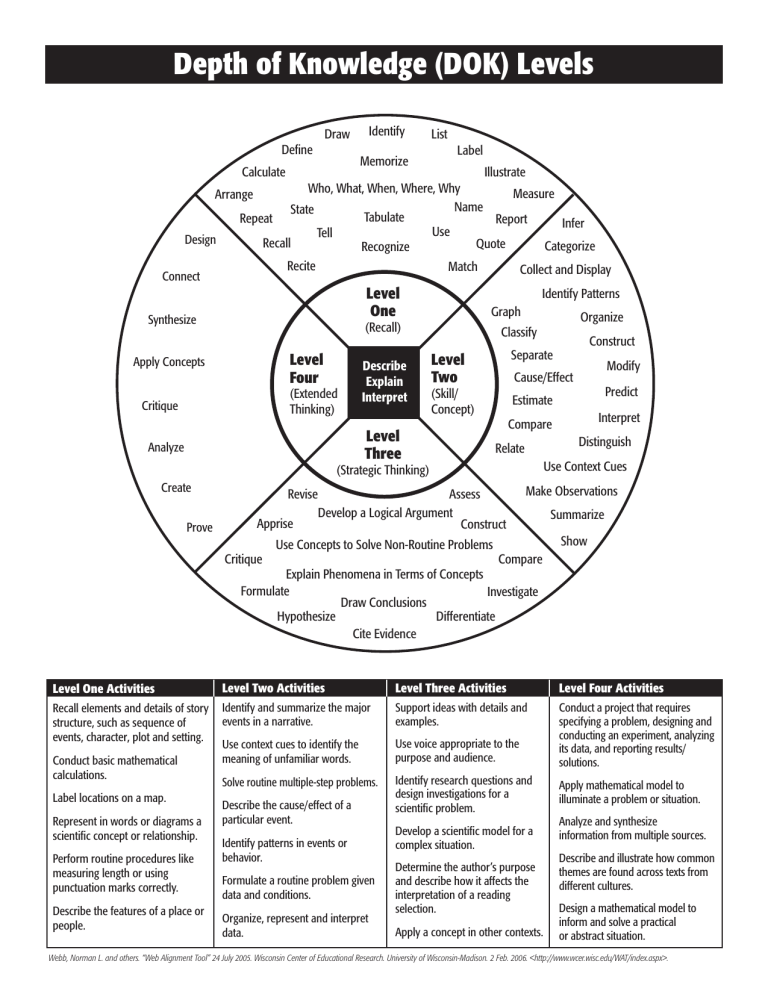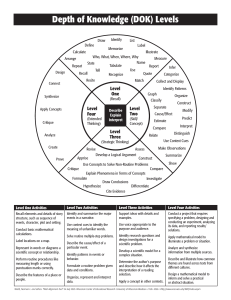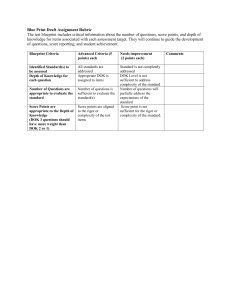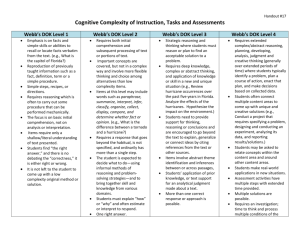
Depth of Knowledge (DOK) Levels Define Identify Draw Memorize List Label Illustrate Who, What, When, Where, Why Measure Arrange Name State Tabulate Repeat Report Infer Use Tell Design Recall Quote Categorize Recognize Recite Match Collect and Display Connect Identify Patterns Level Graph One Organize Synthesize (Recall) Classify Construct Separate Level Level Apply Concepts Describe Modify Cause/Effect Two Four Explain Predict (Skill/ (Extended Interpret Estimate Critique Concept) Thinking) Interpret Compare Level Distinguish Analyze Relate Calculate Three Use Context Cues (Strategic Thinking) Create Prove Revise Apprise Assess Develop a Logical Argument Construct Make Observations Use Concepts to Solve Non-Routine Problems Summarize Show Compare Explain Phenomena in Terms of Concepts Formulate Investigate Draw Conclusions Hypothesize Differentiate Cite Evidence Critique Level One Activities Level Two Activities Level Three Activities Level Four Activities Recall elements and details of story structure, such as sequence of events, character, plot and setting. Identify and summarize the major events in a narrative. Support ideas with details and examples. Use context cues to identify the meaning of unfamiliar words. Use voice appropriate to the purpose and audience. Conduct a project that requires specifying a problem, designing and conducting an experiment, analyzing its data, and reporting results/ solutions. Solve routine multiple-step problems. Identify research questions and design investigations for a scientific problem. Conduct basic mathematical calculations. Label locations on a map. Represent in words or diagrams a scientific concept or relationship. Perform routine procedures like measuring length or using punctuation marks correctly. Describe the features of a place or people. Describe the cause/effect of a particular event. Identify patterns in events or behavior. Formulate a routine problem given data and conditions. Organize, represent and interpret data. Develop a scientific model for a complex situation. Determine the author’s purpose and describe how it affects the interpretation of a reading selection. Apply a concept in other contexts. Apply mathematical model to illuminate a problem or situation. Analyze and synthesize information from multiple sources. Describe and illustrate how common themes are found across texts from different cultures. Design a mathematical model to inform and solve a practical or abstract situation. Webb, Norman L. and others. “Web Alignment Tool” 24 July 2005. Wisconsin Center of Educational Research. University of Wisconsin-Madison. 2 Feb. 2006. <http://www.wcer.wisc.edu/WAT/index.aspx>. DOK Question Stems DOK 1 • Can you recall______? • When did ____ happen? • Who was ____? • How can you recognize____? • What is____? • How can you find the meaning of____? • Can you recall____? • Can you select____? • How would you write___? • What might you include on a list about___? • Who discovered___? • What is the formula for___? • Can you identify___? • How would you describe___? DOK 2 • Can you explain how ____ affected ____? • How would you apply what you learned to develop ____? • How would you compare ____? Contrast_____? • How would you classify____? • How are____alike? Different? • How would you classify the type of____? • What can you say about____? • How would you summarize____? • How would you summarize___? • What steps are needed to edit___? • When would you use an outline to ___? • How would you estimate___? • How could you organize___? • What would you use to classify___? • What do you notice about___? DOK 3 • How is ____ related to ____? • What conclusions can you draw _____? • How would you adapt____to create a different____? • How would you test____? • Can you predict the outcome if____? • What is the best answer? Why? • What conclusion can be drawn from these three texts? • What is your interpretation of this text? Support your rationale. • How would you describe the sequence of____? • What facts would you select to support____? • Can you elaborate on the reason____? • What would happen if___? • Can you formulate a theory for___? • How would you test___? • Can you elaborate on the reason___? DOK 4 • Write a thesis, drawing conclusions from multiple sources. • Design and conduct an experiment. Gather information to develop alternative explanations for the results of an experiment. • Write a research paper on a topic. • Apply information from one text to another text to develop a persuasive argument. • What information can you gather to support your idea about___? • DOK 4 would most likely be the writing of a research paper or applying information from one text to another text to develop a persuasive argument. • DOK 4 requires time for extended thinking. From Depth of Knowledge – Descriptors, Examples and Question Stems for Increasing Depth of Knowledge in the Classroom Developed by Dr. Norman Webb and Flip Chart developed by Myra Collins Depth of Knowledge –Level 3 Students provide support for reasoning, apply complex and abstract thinking, and make decisions. Engagement Prompts What makes ____better than/superior to_____? Explain or connect ideas using supporting evidence to ______. Analyze/synthesize information within one data source or text. What is the recurring theme in _________? Provide supporting details. Support your rationale. Evaluate and provide rationale. Verify the reasonableness of _______________. What is your interpretation of _______________? Cite evidence and develop a logical argument for ______________. How is ___________ related to _______________? How would you adapt _____________to____________? How would your test _________________? What would happen if ________________? Strategic thinking DOK Level 3 requires higher cognitive demands than the previous levels. Students explain/justify thinking and provide supporting evidence for reasoning or conclusions drawn. Level 3 tasks typically require reasoning, complexity, developing a plan or sequence of steps, and have more than one possible response or solution. *From Dept-of –knowledge Levels for Four Content Areas by Webb, N. Depth of Knowledge –Level 4 Students make connections, related ideas within the content or among content areas, and devise one approach among alternatives on how a situation can be solved. Engagement Prompts Investigate and draw conclusions about how _____ impacts the world today. How would you adapt ____to create ______that would be applicable in the real world? Analyze and explain multiple perspectives/issues within or across time periods, events, or cultures. Analyze how similar themes or ideas are developed in multiple texts. Evaluate for real-world occurrence. Design ___to improve___. Justify your choice. Gather, organize, and interpret information from multiple sources. Write a research report. Extended thinking DOK Level 4 requires complex reasoning and time to research, plan, and problem solve, and think. Tasks involve investigation or application to the real world and include none-routine manipulations or connections with and across discipline, content areas, and multiple sources. Students select one approach among many alternatives. Tasks usually occur over an extended period of time Revised Bloom’s Taxonomy Level 4 Apply The student makes use of information in a context different from the one in which it was learned. Revised Bloom’s Taxonomy Level 5 Analyze The student breaks learned information into parts to explore understandings and relationships. Engagement Prompts Engagement Prompts Which other way would you choose to __________? Use other attributes/characteristics to group/sort _____. Explain another situation where __________. Which factors would you change if __________? What questions would you ask of ___________? Which actions would you take if ____________? What would the result be if ___________? Why does _________Work? Determine if the information is based on fact or opinion. Explain what must have happened when_______. What conclusions can you draw_____________? Which events could not have happed? What is similar to or different from_________? What is the motive/underlying them/message________? What are other possible outcomes? Distinguish between ___________. What is the relationship________? Apply (level 4) Carry out or use a procedure in a given situation Revised Bloom’s Taxonomy Level 6 Create The student creates new ideas, products, or viewpoints from previously learned information. Engagement Prompts What changes could you make to revise_____? What theory can you propose for _______? Develop a plan/proposal that ________? What might be a solution to ________? How many ways can you __________? How could you improve__________? Devise your own way to __________. What might happen if ____________? Generate hypotheses ____________. What are the alternatives? Design a ___________to ______________. Analyze (level 5) Create (Level 6) Break down a concept or idea into parts and Combine elements or ideas to form a whole; determine the relationships among the parts. reorganized elements or ideas into new patterns or structures. Cognitive Processes Carrying out Executing Implementing Using Cognitive Processes Differentiation Discrimination Distinguishing Finding Coherence Focusing Integrating Attributing Deconstruction Outlining Organizing *From Dept-of –knowledge Levels for Four Content Areas by Webb, N. Cognitive Processes Construction Hypothesizing Designing Planning Generating Producing Making Connections Grades 6-12








